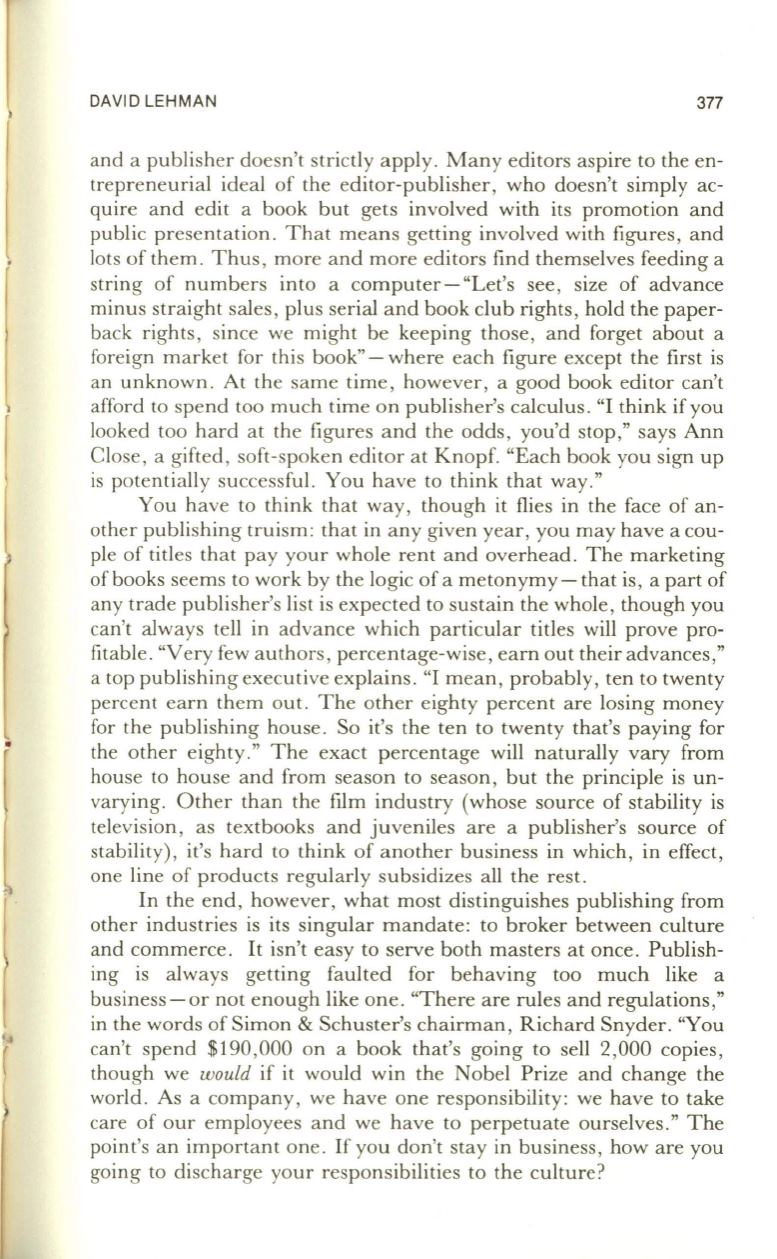
DAVID LEHMAN
377
and a publisher doesn't strictly apply. Many editors aspire to the en–
trepreneurial ideal of the editor-publisher, who doesn't simply ac–
quire and edit a book but gets involved with its promotion and
public presentation. That means getting involved with figures, and
lots of them . Thus, more and more editors find themselves feeding a
string of numbers into a computer-"Let's see, size of advance
minus straight sales, plus serial and book club rights, hold the paper–
back rights , since we might be keeping those, and forget about a
foreign market for this book" - where each figure except the first is
an unknown. At the same time, however, a good book editor can't
afford to spend too much time on publisher's calculus. "I think if you
looked too hard at the figures and the odds, you'd stop," says Ann
Close , a gifted, soft-spoken editor at Knopf. "Each book you sign up
is potentially successful. You have to think that way."
You have to think that way, though it flies in the face of an–
other publishing truism: that in any given year, you may have a cou–
ple of titles that pay your whole rent and overhead. The marketing
of books seems to work by the logic of a metonymy - that is, a part of
any trade publisher's list is expected to sustain the whole, though you
can't always tell in advance which particular titles will prove pro–
fitable. "Very few authors, percentage-wise, earn out their advances,"
a top publishing executive explains. "I mean, probably, ten to twenty
percent earn them out. The other eighty percent are losing money
for the publishing house. So it's the ten to twenty that's paying for
the other eighty." The exact percentage will naturally vary from
house to house and from season to season, but the principle is un–
varying. Other than the film industry (whose source of stability is
television, as textbooks and juveniles are a publisher's source of
stability), it's hard to think of another business in which, in effect,
one line of products regularly subsidizes all the rest.
In the end, however, what most distinguishes publishing from
other industries is its singular mandate: to broker between culture
and commerce.
It
isn't easy to serve both masters at once. Publish–
ing is always getting faulted for behaving too much like a
business - or not enough like one . "There are rules and regulations,"
in the words of Simon
&
Schuster's chairman, Richard Snyder. "You
can't spend $190,000 on a book that's going to sell 2,000 copies,
though we
would
if it would win the Nobel Prize and change the
world . As a company , we have one responsibility: we have to take
care of our employees and we have to perpetuate ourselves." The
point's an important one . If you don't stay in business, how are you
going to discharge your responsibilities to the culture?


